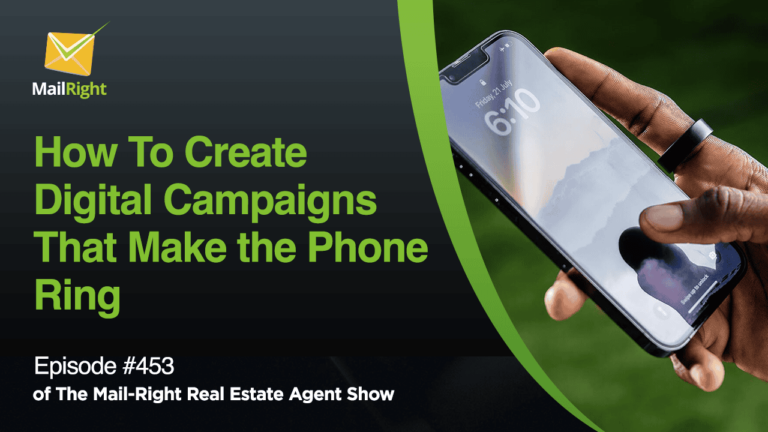Does your real estate newsletter seem boring? In Episode 403rd of Mail-Right Show, Robert Newnan and Jonathan Denwood shared practical tips for creating a captivating newsletter, from headlines to content, to help real estate agents boost their engagement levels. Robert Newman is the founder of Inbound REM, an inbound marketing agency, and has over a decade of experience in the real estate SEO industry. On the other hand, Jonathan Denwood is the joint founder of Mail-Right, a CRM and lead generation platform, and also provides beautiful WordPress Websites with IDX functionality, all combined in one great package.
Newsletters are done mainly by email. Before email was a thing, people used to hand stamp, hand mail, and send out bulk emails or newsletters that used to look like Pennysaver for as low as ten cents per piece of mail. Pennysaver was a little throwaway-like coupon that used to get mailed out to everybody before when coupons were super popular, and realtors also used it to advertise. That gave some realtors the idea of sending out their newsletter with little coupons from local vendors.
Today, newsletters are changing. They are now more about the lifestyle or how capable someone is of being a news resource of the local area. This happens because there’s a lot of advertising and promotional content everywhere. When you check your email, you’ll see a huge stack of messages, and they all want your attention. So, newsletters must provide valuable, helpful information about your local area to stand out.
Regularly Scrub Your Email
Not scrubbing your email list can affect the newsletters you send, affecting how recipients view your emails and the chances of getting to your target audience’s inbox.
The good thing is there are services available to test your email list and see if there are issues, such as bouncing emails, or if the emails are being utilized. You should remove these emails with problems that can hurt the chances of your newsletter reaching its target audience.
To maintain a healthy email list, you can utilize services to perform regular clean-ups at least once a year. Some services even offer automated features to remove or stop sending emails to those who haven’t opened the email a certain number of times. If you’re new to email marketing, Mailchimp is a user-friendly option that offers many functionalities. Alternatively, you can use Robly, a marketer’s tool that is ideal for those who pay attention to their statistics, manage lists, and work on building big lists with clear goals in mind.
Subject Line
There are several tools available to help you in writing engaging titles, particularly for email subject lines. HubSpot is among those tools that have some of the best subject lines you can ever see. They have a very good content team, with those who read the content, marketers, and create interesting subject lines that pique one’s interest. Another service worth exploring is Anyword.com, which offers an email subject line generator. Additionally, AI tools like Word Hero can also be helpful.
However, it’s essential to remember that when creating a subject line, you should put yourself in the shoes of the recipient of the email or newsletter. Consider whether, upon seeing the title, they would save and open the email or simply delete it.
Write Compelling Content
Compelling content should share the ‘who, what, when, why, and where’ of something that is close and personal to the people to whom you’re sending the email.
Furthermore, whether you’re a content creator, blogger, or podcast producer, research is the crucial yet often overlooked, initial step. Research involves keyword research, utilizing tools like Google Insights, and employing some basic marketing techniques. However, if you lack marketing expertise, a simple yet effective approach is to engage with the people you’re interested in, even if you’re not directly selling to them. For instance, you can ask your friends and family about their experiences searching for a home. Learn how they conducted their search, whether online or offline, and what factors they considered. While informal discussions can be valuable, remember that robust market research tools are also available to enhance the research process.
You should identify topics that align with what people are actively searching for, helping you craft content that resonates with your email recipients. Keyword research can also provide insight into internet user behavior, specifically within Google. But note that you shouldn’t use a hashtag research tool because what people care about on social media and what people care about on high-intent search engines are different.
Furthermore, if you have a niche, creating compelling content becomes more straightforward. However, combining your niche with curation can be even more effective. This involves concentrating on your niche for the main content while incorporating a sidebar or section dedicated to local stories.
For instance, if you’re producing a monthly newsletter, consider curating a list of news stories relevant to the property. Throughout the month, gather relevant news stories from local sources and store them in a subfolder. When writing your newsletter, select three or four from those stories, including the title, link, and a summary for your curation section.
Another effective strategy is to document case studies with the permission of your clients and present them in a storytelling format. A case study in this context is the experiences of your client when buying or selling a home. You can add humor or interesting elements to make the story more engaging. Real-life details, facts, figures, and statistics significantly enhance the content’s impact, especially when authentic. For example, consider a scenario where a buyer pursued 35 properties, showcasing perseverance amidst numerous setbacks. They made a stronger offer in their second attempt, increasing it by 50%. However, they were outbid by someone offering 30% above the asking price in just two hours. These real-life challenges resonate more with people than a straightforward story of making a dozen offers and buying a house. Creating case studies with your clients’ permission that reflect these real-life experiences is an effective engagement tool.
Another example of an effective strategy is someone who searches for talented artists in two small cities, each with fewer than 100,000 residents, located in the New Jersey suburbs where they conduct business. Throughout the year, they gather artwork from selected artists, and by the end of the year, they choose their favorite pieces from the previous year and transform them into postcards. The artists sign these postcards and this person sends them to their customers, who often display them on their refrigerators. The aim is to connect with residents of these two communities. This person gained recognition from Coldwell Banker Global, and their strategy accounts for 50% of their business. While not a traditional newsletter, they invest substantial time and effort into crafting the content for these postcards. This unique strategy consistently generates a substantial Gross Commission Income (GCI) each year.
Analytics is Important
When sending emails, you should know your numbers, as they speak a lot. If you don’t measure something, it’s really hard to get the result that you’re looking for.
It’s a universal aspect of human nature that most people prefer entertainment over hard work. If every individual consistently tries to get the necessary knowledge and take the required actions, they could potentially achieve financial success. However, self-discipline is difficult to establish. Therefore, content producers should focus on creating engaging and attention-grabbing content. Note that this advice does not apply to direct real estate marketing, but this distinction is not evident unless you track the analytics.
For realtors moving to a new market, remember to engage your audience. Consider everyone you’ve ever interacted with as a part of your customer family, and build your brand accordingly. Each person you’ve spoken to is valuable. To deliver a high-quality branding message, which should be informative, utilize email as a central component of your strategy. Email serves as a means to communicate with everyone you’ve engaged with, but you can also use video updates. Employing both email and video can be highly effective.






